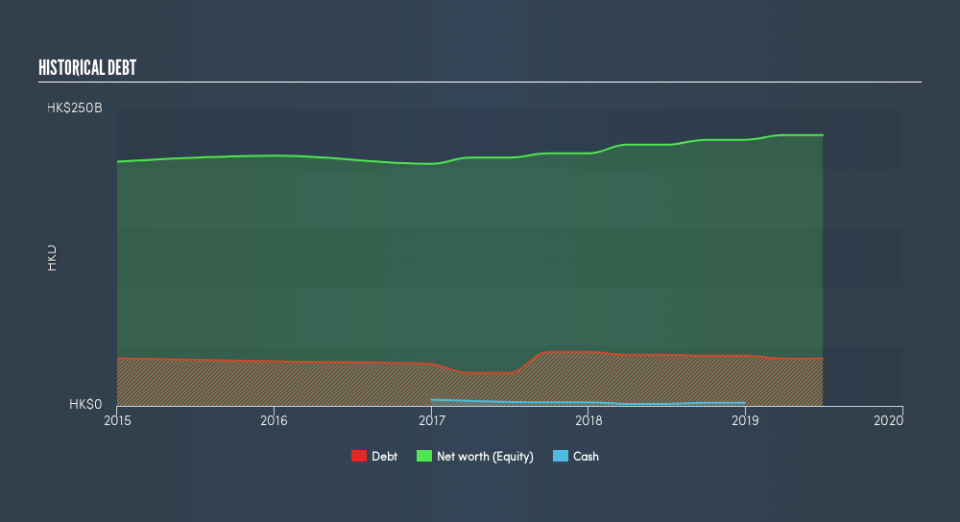These 4 Measures Indicate That Wharf Real Estate Investment (HKG:1997) Is Using Debt Reasonably Well

David Iben put it well when he said, 'Volatility is not a risk we care about. What we care about is avoiding the permanent loss of capital.' So it seems the smart money knows that debt - which is usually involved in bankruptcies - is a very important factor, when you assess how risky a company is. Importantly, Wharf Real Estate Investment Company Limited (HKG:1997) does carry debt. But should shareholders be worried about its use of debt?
When Is Debt Dangerous?
Generally speaking, debt only becomes a real problem when a company can't easily pay it off, either by raising capital or with its own cash flow. In the worst case scenario, a company can go bankrupt if it cannot pay its creditors. While that is not too common, we often do see indebted companies permanently diluting shareholders because lenders force them to raise capital at a distressed price. Having said that, the most common situation is where a company manages its debt reasonably well - and to its own advantage. The first thing to do when considering how much debt a business uses is to look at its cash and debt together.
See our latest analysis for Wharf Real Estate Investment
How Much Debt Does Wharf Real Estate Investment Carry?
The image below, which you can click on for greater detail, shows that Wharf Real Estate Investment had debt of HK$39.8b at the end of June 2019, a reduction from HK$43.1b over a year. However, because it has a cash reserve of HK$2.68b, its net debt is less, at about HK$37.1b.
How Strong Is Wharf Real Estate Investment's Balance Sheet?
Zooming in on the latest balance sheet data, we can see that Wharf Real Estate Investment had liabilities of HK$15.1b due within 12 months and liabilities of HK$40.3b due beyond that. Offsetting these obligations, it had cash of HK$2.68b as well as receivables valued at HK$950.0m due within 12 months. So its liabilities outweigh the sum of its cash and (near-term) receivables by HK$51.7b.
Wharf Real Estate Investment has a very large market capitalization of HK$134.7b, so it could very likely raise cash to ameliorate its balance sheet, if the need arose. But we definitely want to keep our eyes open to indications that its debt is bringing too much risk.
In order to size up a company's debt relative to its earnings, we calculate its net debt divided by its earnings before interest, tax, depreciation, and amortization (EBITDA) and its earnings before interest and tax (EBIT) divided by its interest expense (its interest cover). The advantage of this approach is that we take into account both the absolute quantum of debt (with net debt to EBITDA) and the actual interest expenses associated with that debt (with its interest cover ratio).
Wharf Real Estate Investment has a debt to EBITDA ratio of 2.8, which signals significant debt, but is still pretty reasonable for most types of business. But its EBIT was about 15.2 times its interest expense, implying the company isn't really paying full freight on that debt. Even if not sustainable, that is a good sign. The bad news is that Wharf Real Estate Investment saw its EBIT decline by 11% over the last year. If earnings continue to decline at that rate then handling the debt will be more difficult than taking three children under 5 to a fancy pants restaurant. When analysing debt levels, the balance sheet is the obvious place to start. But it is future earnings, more than anything, that will determine Wharf Real Estate Investment's ability to maintain a healthy balance sheet going forward. So if you're focused on the future you can check out this free report showing analyst profit forecasts.
Finally, a business needs free cash flow to pay off debt; accounting profits just don't cut it. So the logical step is to look at the proportion of that EBIT that is matched by actual free cash flow. During the last three years, Wharf Real Estate Investment produced sturdy free cash flow equating to 71% of its EBIT, about what we'd expect. This cold hard cash means it can reduce its debt when it wants to.
Our View
Wharf Real Estate Investment's interest cover was a real positive on this analysis, as was its conversion of EBIT to free cash flow. Having said that, its EBIT growth rate somewhat sensitizes us to potential future risks to the balance sheet. Looking at all this data makes us feel a little cautious about Wharf Real Estate Investment's debt levels. While we appreciate debt can enhance returns on equity, we'd suggest that shareholders keep close watch on its debt levels, lest they increase. Another positive for shareholders is that it pays dividends. So if you like receiving those dividend payments, check Wharf Real Estate Investment's dividend history, without delay!
Of course, if you're the type of investor who prefers buying stocks without the burden of debt, then don't hesitate to discover our exclusive list of net cash growth stocks, today.
We aim to bring you long-term focused research analysis driven by fundamental data. Note that our analysis may not factor in the latest price-sensitive company announcements or qualitative material.
If you spot an error that warrants correction, please contact the editor at editorial-team@simplywallst.com. This article by Simply Wall St is general in nature. It does not constitute a recommendation to buy or sell any stock, and does not take account of your objectives, or your financial situation. Simply Wall St has no position in the stocks mentioned. Thank you for reading.

